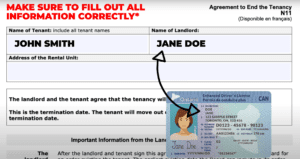For our audio-visual learners, here’s a 5-minute video on How to Serve an N11 form in Ontario.
Table of Contents
Understanding the N11 Form in Ontario: A Mutual Agreement to End Tenancy
Hello everyone, Property Hustlers here. For this blog, we want to share some essential insights on utilizing the form in Ontario, a standard agreement for mutual eviction or mutually ending a tenancy.
What is an N11 Form?
The N11 form, often referred to as a mutual agreement to end tenancy, is used when both the landlord and tenant decide to terminate the tenancy amicably. This form adds a layer of formality to the agreement and is particularly useful when there are no disputes between the parties involved.
Download a form here: N11 Form LTB Ontario
When and Why to Use the N11 Form
Landlords often make informal agreements with their tenants to end a tenancy, but it’s crucial to formalize these agreements using the form. This formalization provides recourse if one party does not uphold their end of the agreement. For instance, if a landlord agrees to release a tenant from their lease or if a landlord seeks to reclaim the rental unit and offers a cash-for-keys deal, the form can legally bind these agreements.
How to Fill Out the N11 Form
To use the form effectively, include detailed and correct information such as your name, the tenant’s name, and the rental address. Ensure that names on the form match those on IDs and lease agreements. If the lease includes multiple tenants, include all their names on the form.

Immediate Enforcement and Legal Recourse
Once the N11 form is signed, landlords can apply immediately to the Landlord and Tenant Board (LTB) to enforce the agreement. This proactive step ensures that if the tenant does not vacate the premises by the agreed date, the landlord can seek eviction through legal channels, saving time and potential future disputes.
Common Uses of the N11 Form
A common scenario for using the form follows the issuance of an N12 form, where a landlord intends to take possession of a rental unit. If the tenant subsequently agrees to move out, they can sign the N11 form, which is often recognized by courts as a continuation of the N12 process.
Final Steps and Recommendations
After securing the tenant’s signature on the N11 form, file it with the LTB immediately. This is a cost-effective strategy to avoid delays and ensure that the tenancy ends smoothly. The filing fee is $201, a worthwhile investment for peace of mind.
Conclusion
The N11 form is a powerful tool for landlords looking to ensure a smooth transition when a tenancy ends. It provides a structured approach to formalizing agreements and offers legal protection for both parties. Always ensure accuracy when completing the form and consider consulting a professional for specific circumstances.
For any questions about LTB Forms or about general inquiries you may have, please don’t hesitate to contact us! We would love to hear from you.
Download a form here: N11 Form LTB Ontario
Start Your Investing Journey
Are you interested in real estate investing? Are you struggling with the high barriers to entry to the Canadian real estate market? Join us now and see how we can help you acquire your first US real estate deal in the next 45 days!
Fill out the application form below and take the first step towards expanding your investment portfolio across the border




